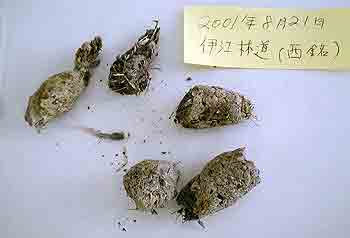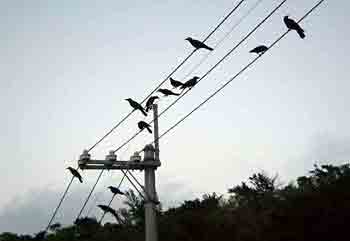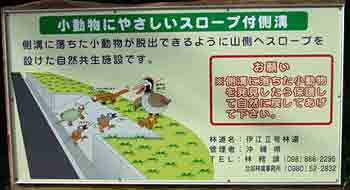- Home >
- OKinawa Rail >
- Declining Population
The Okinawa Rail
Declining Okinawa Rail Population
This page explains the decline in the Okinawa Rail population and the reasons behind it.
The main reason for the decline of the Okinawa Rail is considered to be predation by Javan Mongoose Herpestes javanicus and feral cats that did not originally exist in the natural world of the Okinawa Island. The creatures in Okinawa Island have evolved over the last millions of years, adapting to the environment where terrestrial predators did not exist. Thus they are not equipped, physically and behaviorally, with ways of protecting themselves from predators, and can get killed very easily once such predators are introduced. Not only the Okinawa Rail but also lizards, frogs and insects endemic to the island are also considered to be threatened by these predators. The Invasive Alien Species Act went into effect in June 2005. The Okinawa Rail and the creatures in Okinawa Island clearly represent the problems posed by invasive alien species.
Okinawa Rail distribution reduction and invasion by mongoose
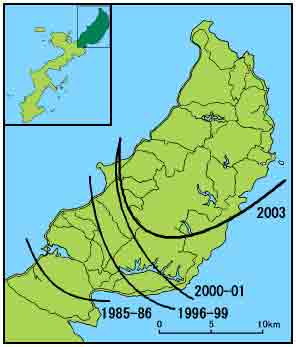 The southern limit of the Okinawa Rail distribution, Okinawa Rail distribution in 2000-01 and 2003, and the number of captured mongoose at around the same time are shown in figures.
The southern limit of the Okinawa Rail distribution, Okinawa Rail distribution in 2000-01 and 2003, and the number of captured mongoose at around the same time are shown in figures.
The southern limit of Okinawa Rail distribution is moving northward in the recent years. The sites of mongoose capture and the distribution of Okinawa Rail do not overlap. In other words, as the mongoose enlarges its distribution the distribution of Okinawa rail gets smaller.
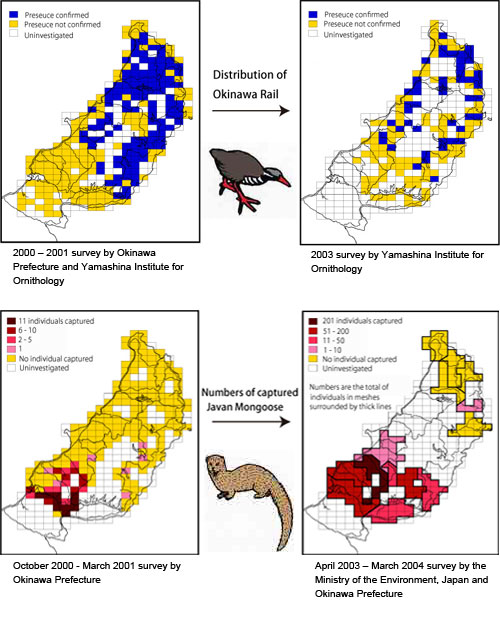
Threats to the survival of the Okinawa Rail
The Okinawa Rail and the endemic species of Okinawa Island face many threats, including predation by introduced species (ie. Javan Mongoose and feral cats) and the Jungle Crow Corvus macrorhynchos which is increasing its population in line with the increase in human population, deforestation, traffic accidents posed by road development, and falls into gutters.
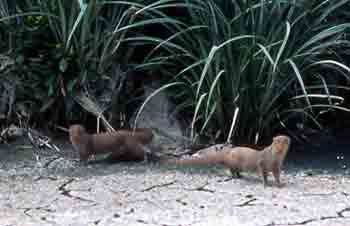
Javan Mongoose Herpestes javanicus introduced to Okinawa Island to control Habu Trimeresurus flavoviridis, a native vonomus snake. (photo by Tetsujiro Harato)
Feather of Okinawa Rail found from cat's feces. Cats have high ability for hunting and can attack and eat adult birds. (photo by Michio Kinjo)
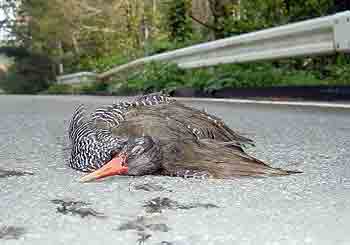
An adult Okinawa Rail killed in a traffic accident along the prefectural road No.70 in Kunigami village in May 2005. (photo courtesy of the Yambaru Wildlife Center, Ministry of the Environment)
Jungle Crow Corvus macrorhynchos are increasing in the Yambaru region. They are suspected of attacking eggs and chicks of the Okinawa Rail.
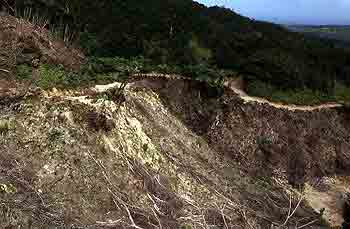
Yambaru forest are subjected to increasing deforestation. Forest is not only reducing in its size and is being fragmented due to road construction. Where the type specimen of Okinawa rail was collected (photograph) is no exception.
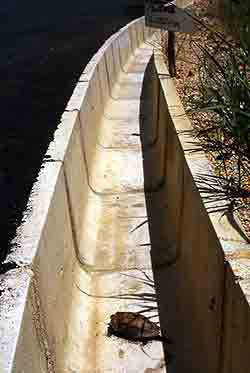
Small animals that fall into the forest road gutters cannot climb out of it and die. The photograph shows a Ryukyu Black-breasted Leaf Turtle Geoemyda japonica, an endemic species of Okinawa and adjacent islands, that could not escape out from a gutter and died.
Presently, some roads have gutters that are sloped on one side, making it possible for fallen animals to climb out.

